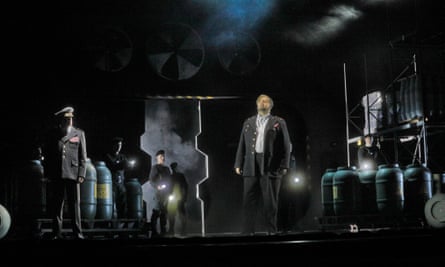In my experience, Wagner gets a different sort of audience from most opera. More men; more people who come along on their own. Verdians, Mozartians come to be enriched and entertained. Perfect Wagnerites come to find the meaning of life.
I was once sitting behind the late Bernard Levin, a noted British journalist and essayist, during a performance of Wagner’s Götterdämmerung, the final part of the Ring cycle, at Covent Garden. At the end of the marathon performance – all of the later Wagner operas are marathons – an excited American woman came up to Levin. “Mr Levin,” she said, “was it significant that Siegfried and Hagen [the villain of the opera] were both wearing green costumes?” She thought she had found the key to the Ring.
Levin pondered for a moment, then gave what I thought was a wonderfully deadpan reply. “No, I don’t think so,” he said. “Probably just some material left over from Don Giovanni.” He was gently trying to tell his interlocutor that the Ring was a work of art, not a puzzle which, if it could be unravelled, would explain everything.
He had a point, of course, but to the acolytes Wagner does feel as if he offers something different – a treatise on life rather than a musical experience. At the end of Tristan und Isolde, which opens at New York’s Metropolitan Opera on Monday, you really do feel as if you have witnessed something revelatory, perhaps even life-changing.
The remarkable Swedish soprano Nina Stemme is singing Isolde, which has become her signature role. I saw Stemme in the part three years ago in Houston and believe me, this will be worth skipping Clinton v Trump for. When Stemme sings the concluding Liebestod (literally love-death), you will – carried along on the waves of sound and emotion – believe what she is telling you. “How gently and quietly he smiles,” she sings over the body of the dead Tristan. “How fondly he opens his eyes. Do you see, friends? Do you not see?” You will see.
This is the climax of a four-hour journey in which Tristan and Isolde find their love for each other thwarted – Isolde is promised in marriage to boring old King Marke. Only in death can they be truly united. The Liebestod – and this is a horribly blokeish and archetypally Wagnerian idea – is a hymn to love and sex, and to the belief that you will never find them perfectly realised in the here and now. Love, sex, death: a holy – or unholy – trinity.
Tristan und Isolde marked a new beginning for Wagner – and indeed for opera. Written in the 1850s, at the same time as he was beginning the Ring, he was moving away from plot-driven romantic operas to meditations on the nature of existence itself. Under the influence of the philosopher Arthur Schopenhauer (who taught him that man’s life on Earth was dominated by unfulfilled longing) and sexual yearning for the married Mathilde Wesendonck (which taught him much the same thing), he had gone all metaphysical, and his work would never be the same again.
“Life and death, the whole import and existence of the outer world, here hang on nothing but the inner movements of the soul,” wrote Wagner. Barry Millington, in The Sorcerer of Bayreuth, marvels at the way he takes a simple love affair – the standard fare of opera for centuries – and turns it into a philosophical disquisition. “Wagner’s opera transcends its scenario of a conventional love story to offer a profound meditation on the nature of the material world, on the metaphysics of subjectivity and on the mysteries of human existence itself,” writes Millington.
Following Schopenhauer, Wagner sees the exterior world as of no consequence. All that matters is the bond – spiritual and (meta)physical – between the two lovers. You could see this as hopelessly, destructively self-indulgent – Tristan and Isolde are the most solipsistic characters in opera – or as profound and moving.

Early reaction was divided: Clara Schumann thought the opera “the most repugnant thing I have ever seen or heard in all my life”, while Friedrich Nietzsche, who at that stage was a committed Wagnerian, called it “the real opus metaphysicum of all art … insatiable and sweet craving for the secrets of night and death … it is overpowering in its simple grandeur”.
Michael Tanner, a modern-day philosopher and opera critic, finds it wonderful but baffling. “It is a work of anti-civilisation,” he writes in his book on Wagner, “and its appeal, the violent and profound effect it has on us, is intimately bound up with that. Even if we don’t subscribe to the gospel of passion which it promulgates, we may still be stirred to the depths by a perfect manifestation … of subversiveness. Tristan has all the classical virtues, put to the most drastically non-classical ends. Its formal impeccableness is solely devoted to propagating the values of something that lies below the level at which form can get a grasp.”
As well as enlarging – or perhaps subverting – the subject matter of opera, Tristan und Isolde also marked a turning point in the history of music. The opening chord in the prelude, the so-called Tristan chord, is seen by some as the beginning of modern music, introducing chromaticism, dissonance and, according to the composer Arnold Schoenberg, even atonality.
“Tristan is the gateway to the rest of Wagner’s music – the drama of Götterdämmerung, the spiritual progress of Parsifal – but it’s also the solar plexus of the whole of 19th-century musical history,” says music critic Tom Service. “Tristan changed every composer who heard it, whether they loved it or loathed it, and the piece opened a Pandora’s box of technical and expressive possibility, of chromatic harmony and vividness of musical thought and feeling, that could never be closed again.” The future really did start here.

Comments (…)
Sign in or create your Guardian account to join the discussion